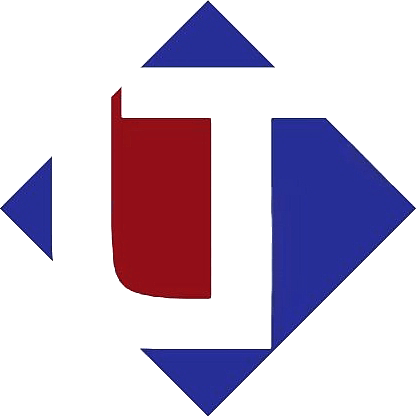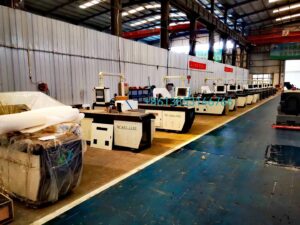Here are the steps to follow when using a copper busbar bending machine:
Choose the right machine: Different copper busbar bending machines have different capabilities, so it is important to choose the right machine for the job. Consider factors such as the size and thickness of the copper busbar, the radius of the bend required, and the type of bend (e.g., U-bend, V-bend, etc.).
Set up the machine: Before using the copper busbar bending machine, make sure that it is properly set up and configured for the job. This may involve adjusting the height and position of the bending rollers, setting the correct speed for the machine, and installing the appropriate bending tool.
Secure the busbar: Before starting the bending process, it is important to secure the copper busbar in place to prevent it from slipping or moving during the bending process. This may involve using clamps or other holding devices or securing the busbar to the machine bed.
Adjust the bending parameters: The parameters of the bending process, such as the speed and pressure applied by the bending rollers, will affect the final shape and quality of the bend. It is important to adjust these parameters to ensure that the desired bend radius and shape are achieved.
Start the bending process: Once the machine is set up and the copper busbar is secured, the bending process can begin. It is important to monitor the bend as it progresses to ensure that it remains on track and to make any necessary adjustments.
Remove the bent busbar: Once the bending process is complete, the bent copper busbar can be removed from the machine. It is important to handle the bent busbar carefully to avoid damaging it or altering its shape.
By following these steps, you can effectively use a copper busbar bending machine to achieve precise and consistent bends in your copper busbar.
Here are a few additional tips for using a copper busbar bending machine:
- Use proper lubrication: Using the correct type of lubrication on the bending rollers and other moving parts of the machine can help to improve the quality of the bend and extend the lifespan of the machine.
- Avoid overbending: Overbending the copper busbar can cause it to break or become damaged, so it is important to avoid overbending. This may involve adjusting the bending parameters, using a slower speed, or making other adjustments as needed.
- Test the bend: Before removing the bent copper busbar from the machine, it is a good idea to test the bend to ensure that it meets the desired specifications. This may involve checking the bend radius, the straightness of the bend, or other factors.
- Clean the machine: After using the copper busbar bending machine, it is important to clean it thoroughly to remove any debris or residue that may have accumulated during the bending process. This can help to maintain the machine’s performance and extend its lifespan.
- Regular maintenance: Regular maintenance is important to keep the copper busbar bending machine operating effectively and efficiently. This may involve cleaning and lubricating the machine, checking the alignment of the bending rollers, or addressing any other issues that may arise.
By following these additional tips, you can ensure that you are using your copper busbar bending machine to its fullest potential and that you are getting the most out of your investment.
Here are a few more points to consider when using a copper busbar bending machine:
- Safety precautions: When using a copper busbar bending machine, it is important to follow all appropriate safety precautions to avoid injury or damage. This may involve wearing protective clothing and equipment, such as gloves and safety glasses, and ensuring that all guards and safety features are in place and functioning properly.
- Accurate measurements: Accurate measurements are critical when using a copper busbar bending machine. Before starting the bending process, it is important to measure and mark the copper busbar to ensure that the correct bend radius and shape are achieved.
- Quality control: Quality control is an important aspect of using a copper busbar bending machine. It is important to establish a quality control system that includes regular inspections and checks to ensure that the bends produced by the machine meet the desired specifications.
- Keep records: Keeping records of the bending process, including the type of bend, the parameters used, and the results, can help to improve the quality of the bends and make it easier to identify and address any problems that may arise.
- Training: It is important for all operators of the copper busbar bending machine to receive the appropriate training in order to use the machine safely and effectively. This may involve attending training courses, reading operating manuals, or observing experienced operators.
By taking these additional factors into consideration, you can ensure that you are using your copper busbar bending machine in the best possible way and that you are producing high-quality bends that meet your requirements.
Here are a few additional tips for using a copper busbar bending machine:
- Choose the right machine: There are many different types of copper busbar bending machines available, and it is important to choose the right one for your needs. Consider factors such as the size and thickness of the copper busbar, the required bend radius, and the volume of bends that need to be produced.
- Plan the bending process: Before starting the bending process, it is important to plan and prepare. This may involve creating a detailed bending schedule, choosing the right tools and materials, and ensuring that you have all of the necessary equipment and supplies on hand.
- Use the correct tools: Using the correct tools and accessories is critical when using a copper busbar bending machine. This may include selecting the right bending dies, punches, and other tools to ensure that the bend is produced accurately and consistently.
- Adjust the machine as needed: Depending on the type of bend being produced and the size and thickness of the copper busbar, it may be necessary to make adjustments to the copper busbar bending machine. This may involve adjusting the speed, the pressure, or other settings to ensure that the bend is produced correctly.
- Monitor the bending process: It is important to closely monitor the bending process to ensure that the bend is being produced accurately and consistently. This may involve using gauges, measuring tools, or other monitoring devices to keep track of the bend radius, the shape of the bend, and other important parameters.
By following these additional tips, you can help to ensure that you are using your copper busbar bending machine effectively and that you are producing high-quality bends that meet your requirements.
The following is the machine for bending, if you want to check more details etc please check the:





